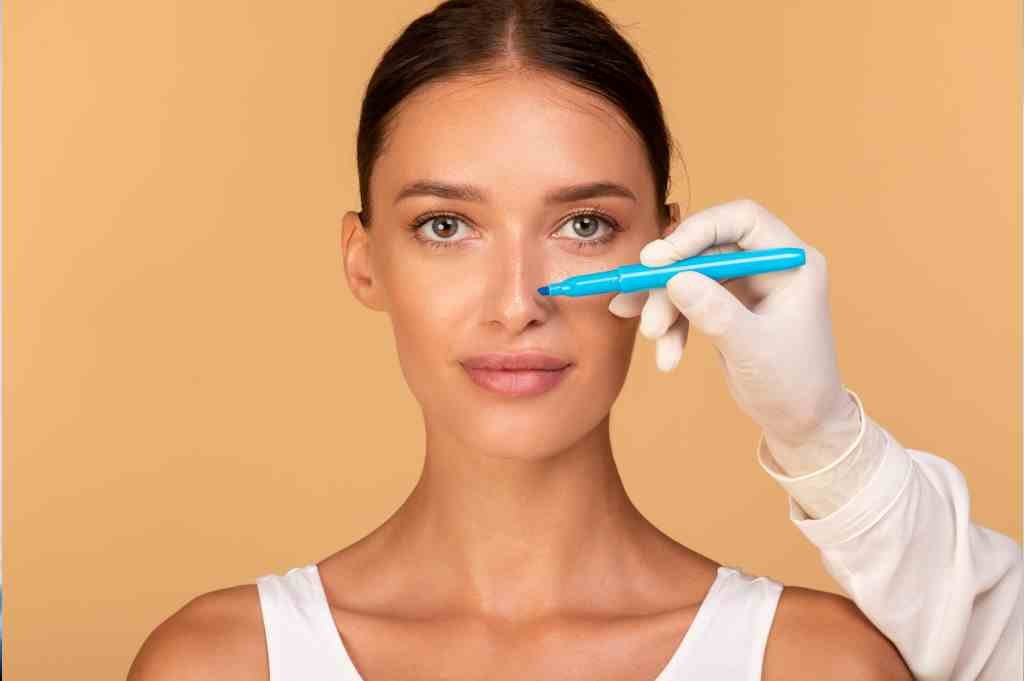Cosmetic Surgery of The Nose
Rhinoplasty
What is an attractive nose? Quite simply, it is a nose that fits your face. It is a natural-looking nose that achieves a harmonious balance with your other facial features. If you feel that your nose is not a good fit, you may benefit from cosmetic surgery of the nose, also called rhinoplasty. Rhinoplasty can enhance the shape, size and general appearance of your nose.
You’ll find basic information about rhinoplasty in this brochure. However, the best way to get complete answers to specific questions that relate to your individual needs is to have a personal consultation with a plastic surgeon certified by the Board of Plastic Surgery.
RHINOPLASTY FAQ
Rhinoplasty can be performed on men and women of almost any age. However, it’s usually recommended that young people wait until facial growth is complete – about age 16 or 17. If you are a teenager, having the procedure should be your own idea.
You may be a good candidate for rhinoplasty if you have any of the following conditions:
• your nose appears too large for your face
• there is a bump or depression on the nasal bridge when viewed in profile
• the nose seems too wide when viewed from the front
• the nasal tip droops or plunges
• the tip is thickened or enlarged
• the nostrils are excessively flared
• your nose is off-center or crooked
• a previous injury has made your nose asymmetrical
A personal consultation is the first step for every patient considering rhinoplasty. During this meeting, your surgeon will assess your physical and emotional health and discuss your specific cosmetic goals for surgery.
You should arrive at the consultation prepared to provide complete information about:
• previous surgeries
• past and present medical conditions
• medical treatments you have received
• medications that you take, including nutritional supplements and herbal remedies
• any allergies that cause congestion or conditions that cause breathing difficulties
• how often you use nasal sprays to relieve congestion.
During your physical evaluation, your plastic surgeon will examine the structures inside your nose and the quality of your skin, as well as the size and shape of your nose and its relationship to your other facial features.
Your plastic surgeon may recommend other treatments that can be performed along with the rhinoplasty to better meet your appearance goals or to improve breathing.
To enhance your appearance:
• Chin surgery can help improve facial balance by making the chin more or less prominent.
To correct breathing difficulties:
• A turbinectomy can open the nasal air passages by reducing the turbinates, the internal projections that warm and moisturize the air that passes through the nose.
• A septoplasty can correct a deviated septum, a condition in which the dividing wall within the nose shifts from the middle to block the air passages.
The technique used for your surgery depends not only on your surgeon’s preferences, but also on your desired results. Alterations may be made to increase or decrease the nasal bridge, reduce the size or width of the nose, narrow the nostrils, reshape the tip, or change the angle between the nose and the upper lip.
Plastic surgeons may perform rhinoplasty from within the nose, making the incision inside the nostrils. This is called a “closed rhinoplasty.” Other times, a surgeon prefers an “open” procedure, in which a small incision is made across the columella, the vertical strip of tissue separating the nostrils, as well as within the nose.
Working through these incisions, the nose’s framework of bone and cartilage is sculpted to the desired shape. Your surgeon may reshape or reposition the bones in your nose, or build up certain areas, using either nasal cartilage or bones and cartilage from another body site, or other materials. The skin and soft tissues are then redraped over the reshaped framework. If the lower part of the nose is being narrowed or the nostrils are being reduced, small wedges of skin at the base of the nostrils may be removed through incisions that are hidden in the nose’s natural creases.
A new era has been opened in aesthetic rhinoplasty operations after a new technique, known as “ Turkish Delight” in the world literature, which was described by Onur Erol in 1989. In this technique, excised cartilage remnants are not devastated but prepared in order to use to re-shape the nasal dorsum and the tip of the nose. The aim of the technique is not only to minimize the errors that can be seen after an ordinary rhinoplasty operation but also leads to construct a new nose with a non-operated look.
Many plastic surgeons abroad started to use this technique in their practices. Whole doctors in ONEP team have learnt this technique from Onur Erol and prefer to use it in their patients.
Each year, thousands of people undergo cosmetic surgery of the nose and experience no major complications. However, it is important for you to be informed of the risks as well as the benefits. One of the most important parts of your consultation is the discussion that you and your surgeon will have about the possible complications of nasal surgery. In addition to listening carefully to what your surgeon tells you, be sure to raise any questions that you may have about the safety of the procedure.
By following your surgeon’s advice and instructions carefully – both before and after surgery – you can do your part to minimize some of the risks.
When the date for your procedure has been set, your plastic surgeon will provide you with specific instructions for the days immediately before and after surgery.
A number of points may be covered, including:
• avoiding certain medications that may complicate surgery or recovery
• stopping smoking for a period of time before and after surgery
• arranging for help and care following surgery.
Rhinoplasty surgery may be performed in an outpatient surgery center, an office-based surgical suite or a hospital. If you are admitted to a hospital or surgery center, your stay will be a short one, perhaps just one night.
Medications are administered to keep you comfortable during the surgical procedure. Local anesthesia and intravenous sedation may be used for patients undergoing rhinoplasty, although general anesthesia may be desirable in some instances. Your plastic surgeon will monitor your physical status throughout the operation and during your recovery.
When the surgery is completed, you’ll be taken to a recovery area. Any discomfort that you feel will be controlled with medication prescribed by your surgeon. A splint may be applied to the bridge of your nose to protect the nose and hold the tissues in place until they have stabilized. You may also have a small, triangular bandage beneath the tip of your nose and packing inside the nostrils, especially if work has been done to improve your breathing.
Although everyone heals at a different rate, you can expect that your recovery will follow this general time line:
The first day:
• In this early stage of healing, you should rest with your head elevated to help minimize swelling
• Activity must be kept to a minimum
• You may experience a small amount of bleeding and stuffiness.
Within 10 days:
• Swelling reaches its peak and then begins to subside
• Bruising will begin to diminish
• You can safely use makeup to conceal any discoloration
• Stitches and packing will dissolve or be removed
• You may discontinue wearing the splint (near the week’s end)
• You may return to school or a nonstrenuous job.
After several weeks:
• You may resume exercise and most of your normal activities
• Most of the swelling will subside.




